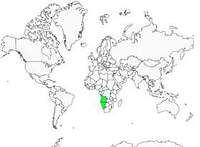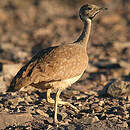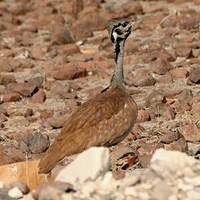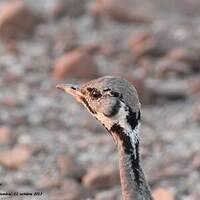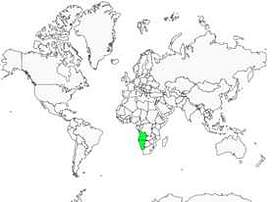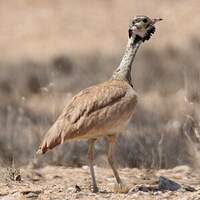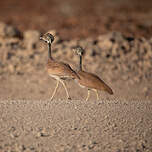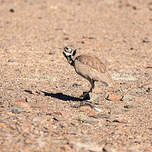Rüppell's Korhaan
Heterotetrax rueppelii - Outarde de Rüppell
Identification
Rüppell's Korhaan has, according to some authors, two subspecies, Eupodotis rueppellii rueppellii and Eupodotis rueppellii fitzsimonsi.
The Rüppell's Korhaan male has a head and neck that are gray-blue. The nape and the upper part of the neck are a light beige. The beak is gray. Several dark lines come to contrast the region of the head and neck. A black eyebrow, more or less continuous, generally extends from the beak to the nape of the neck. A black band runs from the throat to the upper chest and another runs from the nape to the back. The upper part of the body is brown, the belly and chest are cream. The legs and the three toes are yellowish. During the breeding season the colors are more intense. The female has a head much less contrasted and duller plumage. The black band on the throat is finer. The juveniles resemble the females. This species can only be confused with Vigors's Korhaan (Eupodotis vigorsii) which differs by much lighter colors on the underside.
It is obvious that in the large desert areas it is not easy to distinguish them.
Subspecific information 2 subspecies
- Heterotetrax rueppelii rueppelii (s Angola, nw Namibia)
- Heterotetrax rueppelii fitzsimonsi (wc Namibia)
Foreign names
- Outarde de Rüppell,
- Sisón de Damaraland,
- sisão-de-rüppell,
- Rüppelltrappe,
- Rüppell-túzok,
- Rüppells Trap,
- Otarda di Rüppell,
- namibtrapp,
- Namibtrappe,
- drop korhan,
- drop damarský,
- Angolatrappe,
- namibiantrappi,
- Woestynkorhaan (Damarakorhaan),
- sisó de Rüppell,
- dropik namibijski,
- Намибийский корхан,
- コノドグロショウノガン,
- 鲁氏鸨,
- 魯佩氏鴇,
Voice song and call
The song of the Rüppell's Korhaan is deep and rhythmic, similar to that of a frog's. It consists of two or three syllables, such as kraak-rak or cRook-rak-rak. The first syllable is emphasized and deeper. This song is heard at dawn and dusk. Pairs sing a deep and resonant "waaa-a-re-e, waaa-a-re-e..." the male beginning first and the female following with three vocalizations.
Its song is similar to the Eupodotis vigorsii's song, but it is delivered a bit louder.
Habitat
Behaviour character trait
Dietfeeding habits
Reproduction nesting
Rüppell's Korhaan is monogamous. Couples are formed for life. The female lays between one to three eggs which are pink in color. The nest is built in a shallow depression which she has scratched out in the ground, then lined with figs, straw and leaves. The location of the nest is chosen with a bush nearby to protect the young from potential predators. The breeding period for the young is between September and February.
Threats - protection
Sources of information
- IOC World Bird List (v14.2), Gill, F and D Donsker (Eds). 2024-04-18.
Other sources of interest
 Specification sheet created on
03/08/2023 by Jean-Pierre Trouillas
Specification sheet created on
03/08/2023 by Jean-Pierre TrouillasTranslation by AI Oiseaux.net
© 1996-2025 Oiseaux.net
- Accipitriformes
- Aegotheliformes
- Anseriformes
- Apodiformes
- Apterygiformes
- Bucerotiformes
- Caprimulgiformes
- Cariamiformes
- Casuariiformes
- Charadriiformes
- Ciconiiformes
- Coliiformes
- Columbiformes
- Coraciiformes
- Cuculiformes
- Eurypygiformes
- Falconiformes
- Galliformes
- Gaviiformes
- Gruiformes
- Leptosomiformes
- Mesitornithiformes
- Musophagiformes
- Nyctibiiformes
- Opisthocomiformes
- Otidiformes
- Passeriformes
- Pelecaniformes
- Phaethontiformes
- Phoenicopteriformes
- Piciformes
- Podargiformes
- Podicipediformes
- Procellariiformes
- Psittaciformes
- Pterocliformes
- Rheiformes
- Sphenisciformes
- Steatornithiformes
- Strigiformes
- Struthioniformes
- Suliformes
- Tinamiformes
- Trogoniformes


